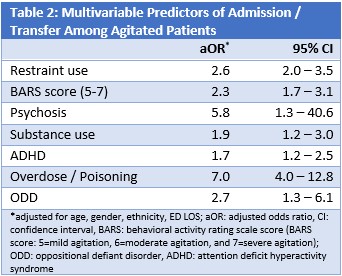Emergency Medicine: All Areas
Category: Abstract Submission
Emergency Medicine I
46 - The Agitated Pediatric Patient Located In the ED: The APPLIED Observational Study
Friday, April 22, 2022
6:15 PM - 8:45 PM US MT
Poster Number: 46
Publication Number: 46.103
Publication Number: 46.103
Matthias M. Manuel, University of Texas Southwestern Medical School, Dallas, TX, United States; Sing-Yi Feng, University of Texas Southwestern Medical School, Dallas, TX, United States; Kenneth Yen, University of Texas Southwestern Medical School, Dallas, TX, United States; FAISALMOHEMED N. PATEL, Children's Health, FRISCO, TX, United States

Matthias M. Manuel, MD, MPH
Fellow, Pediatric Emergency Medicine
University of Texas Southwestern Medical School
Dallas, Texas, United States
Presenting Author(s)
Background: Focused research on pediatric agitation is lacking, despite being a common mental and behavioral health (MBH) emergency. Prevalence of pediatric agitation remains unknown and prior reports may have underestimated rates of restraint use for acute agitation.
Objective: To provide a focused evaluation of the prevalence and predictors of pediatric agitation and restraint use, as well as ED length-of-stay (EDLOS) and admission rate for agitated patients.
Design/Methods: We reviewed records of patients ≤18 years with MBH needs who visited the pediatric-ED of a tertiary-care-hospital over a 3-year-period. We identified and ascertained agitated/aggressive patients using clinical encounter documentation, disease diagnostic codes, and behavioral-activity-rating-scale (BARS) scores. We performed appropriate descriptive and multivariable logistic regression analyses using SAS-9.4®
Results: Of 10,172 patients with MBH needs, 1408 (13.8%) were agitated/aggressive. Of these (n=1408), 63.7% were males and mean age was 11.9 years. Among agitated patients, prevalence of restraint use was 28.7%, with predominance of pharmacologic restraint with atypical antipsychotics. Non-Hispanic Blacks were more likely to be agitated (aOR:1.8, CI:1.2-2.7), but not restrained (aOR:0.8, CI:0.3-1.8). Multivariable predictors of restraint use among agitated patients include, history of ADHD-(aOR:2.2, CI:1.5-3.3), autism-(aOR:2.9, CI:1.9-4.5), conduct disorder-(aOR:1.7, CI:1.2-2.5), psychosis-(aOR:14.3, CI:2.5-271.8), and substance use/overdose states-(aOR:1.9, CI:1.2-3.2). Restrained agitated patients had longer EDLOS-(8.4 vs. 5.0 hours, p< .0001) and higher admission rates-(aOR:2.6, CI:2.0-3.5). Depression-(aOR:0.4, CI:0.3-0.5) and suicidality-(aOR:0.2, CI:0.1-0.3) were protective against agitation and restraint use.Conclusion(s): Prevalence of acute agitation and restraint use in pediatric-EDs may be higher than previously reported. Predictors of acute agitation and restraint use among MBH patients were consistent with prior reports. Restrained agitated patients had longer EDLOS and admission-rate.
CV_Matthias.ManuelMatthias_Manuel_ CV.1.5.2022.pdf
Predictors of admission for agitated patients
Objective: To provide a focused evaluation of the prevalence and predictors of pediatric agitation and restraint use, as well as ED length-of-stay (EDLOS) and admission rate for agitated patients.
Design/Methods: We reviewed records of patients ≤18 years with MBH needs who visited the pediatric-ED of a tertiary-care-hospital over a 3-year-period. We identified and ascertained agitated/aggressive patients using clinical encounter documentation, disease diagnostic codes, and behavioral-activity-rating-scale (BARS) scores. We performed appropriate descriptive and multivariable logistic regression analyses using SAS-9.4®
Results: Of 10,172 patients with MBH needs, 1408 (13.8%) were agitated/aggressive. Of these (n=1408), 63.7% were males and mean age was 11.9 years. Among agitated patients, prevalence of restraint use was 28.7%, with predominance of pharmacologic restraint with atypical antipsychotics. Non-Hispanic Blacks were more likely to be agitated (aOR:1.8, CI:1.2-2.7), but not restrained (aOR:0.8, CI:0.3-1.8). Multivariable predictors of restraint use among agitated patients include, history of ADHD-(aOR:2.2, CI:1.5-3.3), autism-(aOR:2.9, CI:1.9-4.5), conduct disorder-(aOR:1.7, CI:1.2-2.5), psychosis-(aOR:14.3, CI:2.5-271.8), and substance use/overdose states-(aOR:1.9, CI:1.2-3.2). Restrained agitated patients had longer EDLOS-(8.4 vs. 5.0 hours, p< .0001) and higher admission rates-(aOR:2.6, CI:2.0-3.5). Depression-(aOR:0.4, CI:0.3-0.5) and suicidality-(aOR:0.2, CI:0.1-0.3) were protective against agitation and restraint use.Conclusion(s): Prevalence of acute agitation and restraint use in pediatric-EDs may be higher than previously reported. Predictors of acute agitation and restraint use among MBH patients were consistent with prior reports. Restrained agitated patients had longer EDLOS and admission-rate.
CV_Matthias.ManuelMatthias_Manuel_ CV.1.5.2022.pdf
Predictors of admission for agitated patients

